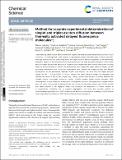Files in this item
Method for accurate experimental determination of singlet and triplet exciton diffusion between thermally activated delayed fluorescence molecules
Item metadata
| dc.contributor.author | Jakoby, Marius | |
| dc.contributor.author | Heidrich, Shahriar | |
| dc.contributor.author | Graf von Reventlow, Lorenz | |
| dc.contributor.author | Degitz, Carl | |
| dc.contributor.author | Madayanad Suresh, Subeesh | |
| dc.contributor.author | Zysman-Colman, Eli | |
| dc.contributor.author | Wenzel, Wolfgang | |
| dc.contributor.author | Richards, Bryce | |
| dc.contributor.author | Howard, Ian | |
| dc.date.accessioned | 2020-12-07T15:58:52Z | |
| dc.date.available | 2020-12-07T15:58:52Z | |
| dc.date.issued | 2020-11-16 | |
| dc.identifier | 271432894 | |
| dc.identifier | 4d2a986f-c6f7-4f06-8ec4-ba8d88f997fc | |
| dc.identifier | 85100240878 | |
| dc.identifier | 000615335100032 | |
| dc.identifier.citation | Jakoby , M , Heidrich , S , Graf von Reventlow , L , Degitz , C , Madayanad Suresh , S , Zysman-Colman , E , Wenzel , W , Richards , B & Howard , I 2020 , ' Method for accurate experimental determination of singlet and triplet exciton diffusion between thermally activated delayed fluorescence molecules ' , Chemical Science , vol. Advance article . https://doi.org/10.1039/D0SC05190J | en |
| dc.identifier.issn | 2041-6520 | |
| dc.identifier.other | ORCID: /0000-0001-7183-6022/work/84315241 | |
| dc.identifier.uri | https://hdl.handle.net/10023/21105 | |
| dc.description | The authors thank the German Research Foundation (DFG) for financial support through SFB 1176 (Project A4) and Helmholtz Energy Materials Foundry HEMF funding of the Helmholtz Association. M.J. acknowledges support from the Karlsruhe School of Optics & Photonics (KSOP) graduate school. SMS thanks the European Union’s Horizon 2020 research and innovation programme under the Marie Sklodowska-Curie grant agreement no 838885 (NarrowbandSSL). The St Andrews team thanks the EPSRC for financial support (EP/P010482/1). | en |
| dc.description.abstract | Understanding triplet exciton diffusion between organic thermally activated delayed fluorescence (TADF) molecules is a challenge due to the unique cycling between singlet and triplet states in these molecules. Although prompt emission quenching allows the singlet exciton diffusion properties to be determined, analogous analysis of the delayed emission quenching does not yield accurate estimations of the triplet diffusion length (because the diffusion of singlet excitons regenerated after reverse-intersystem crossing needs to be accounted for). Herein, we demonstrate how singlet and triplet diffusion lengths can be accurately determined from accessible experimental data, namely the integral prompt and delayed fluorescence. In the benchmark materials 4CzIPN and 4TCzBN, we show that the singlet diffusion lengths are (9.1 ± 0.2) and (12.8 ± 0.3) nm, whereas the triplet diffusion lengths are negligible, and certainly less than 1.0 and 1.2 nm, respectively. Theory confirms that the lack of overlap between the shielded lowest unoccupied molecular orbitals (LUMOs) hinders triplet motion between TADF chromophores in such molecular architectures. Although this cause for the suppression of triplet motion does not occur in molecular architectures that rely on electron resonance effects (e.g. DiKTa), we find that triplet diffusion is still negligible when such molecules are dispersed in a matrix material at a concentration sufficiently low to suppress aggregation. The novel and accurate method of understanding triplet diffusion in TADF molecules will allow accurate physical modeling of OLED emitter layers (especially those based on TADF donors and fluorescent acceptors). | |
| dc.format.extent | 750647 | |
| dc.language.iso | eng | |
| dc.relation.ispartof | Chemical Science | en |
| dc.subject | QD Chemistry | en |
| dc.subject | DAS | en |
| dc.subject.lcc | QD | en |
| dc.title | Method for accurate experimental determination of singlet and triplet exciton diffusion between thermally activated delayed fluorescence molecules | en |
| dc.type | Journal article | en |
| dc.contributor.sponsor | European Commission | en |
| dc.contributor.sponsor | EPSRC | en |
| dc.contributor.institution | University of St Andrews. School of Chemistry | en |
| dc.contributor.institution | University of St Andrews. Organic Semiconductor Centre | en |
| dc.contributor.institution | University of St Andrews. EaSTCHEM | en |
| dc.identifier.doi | 10.1039/D0SC05190J | |
| dc.description.status | Peer reviewed | en |
| dc.identifier.grantnumber | 838885 | en |
| dc.identifier.grantnumber | EP/P010482/1 | en |
This item appears in the following Collection(s)
Items in the St Andrews Research Repository are protected by copyright, with all rights reserved, unless otherwise indicated.

